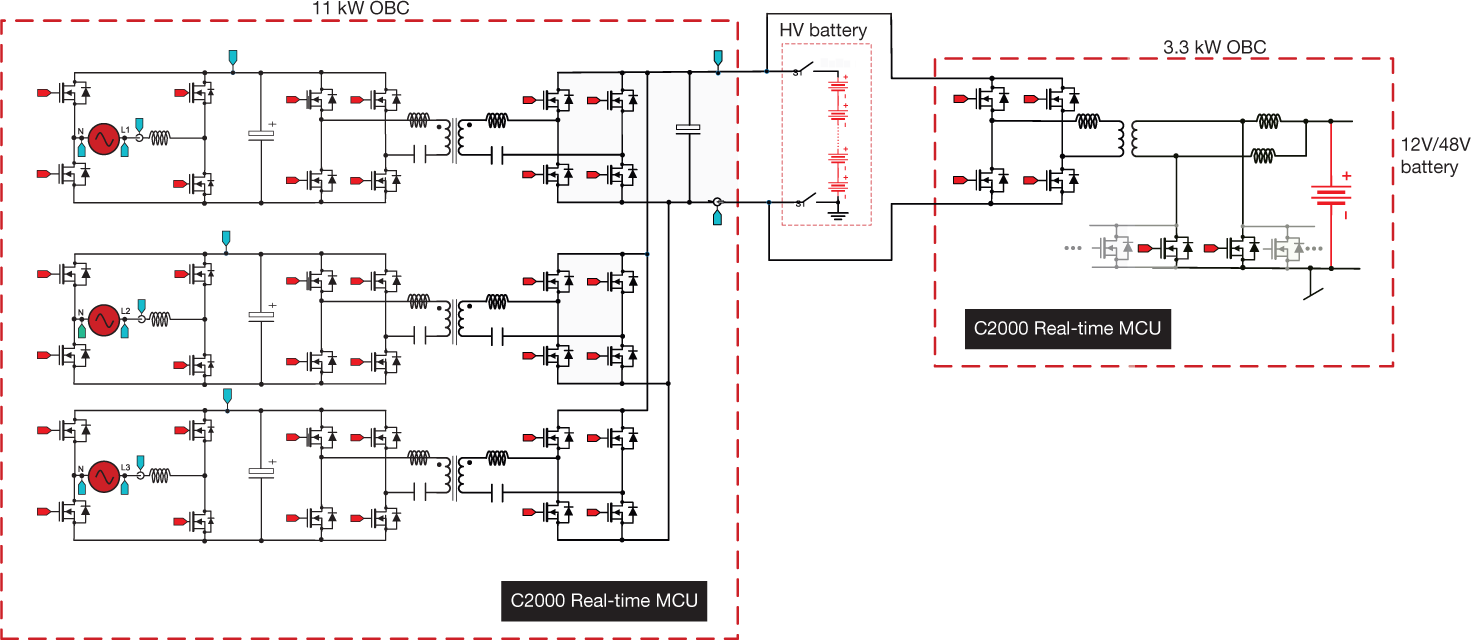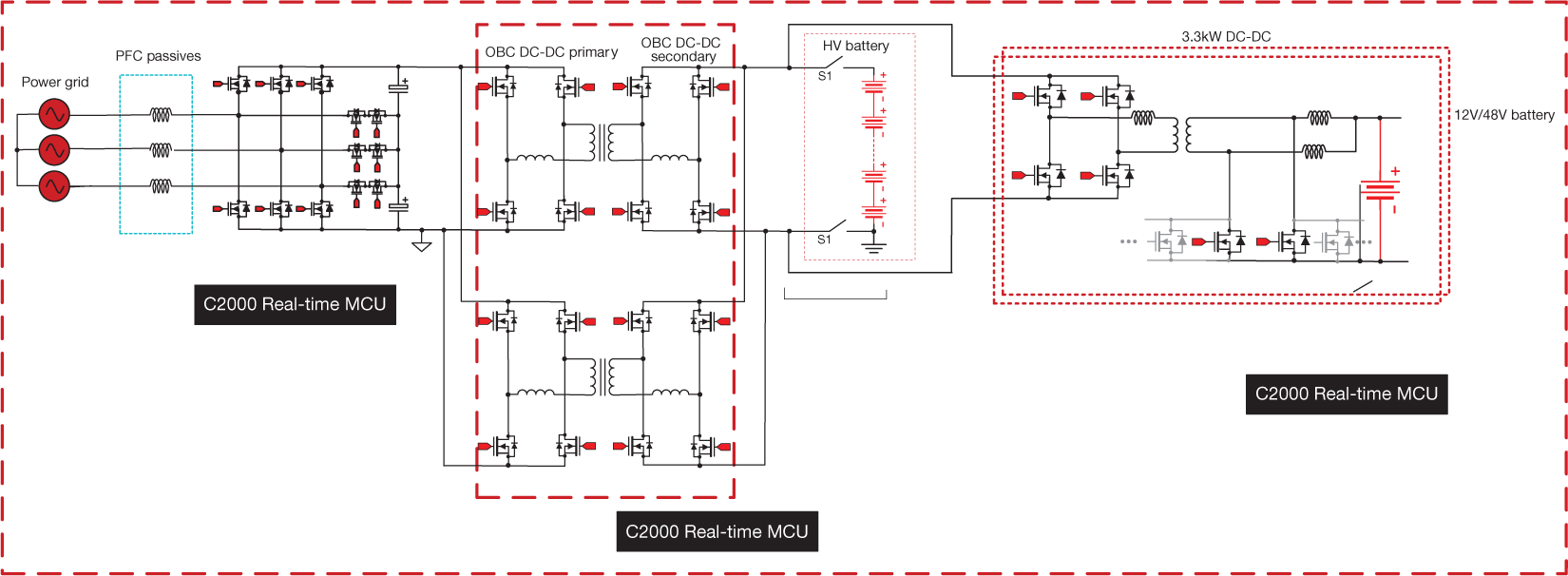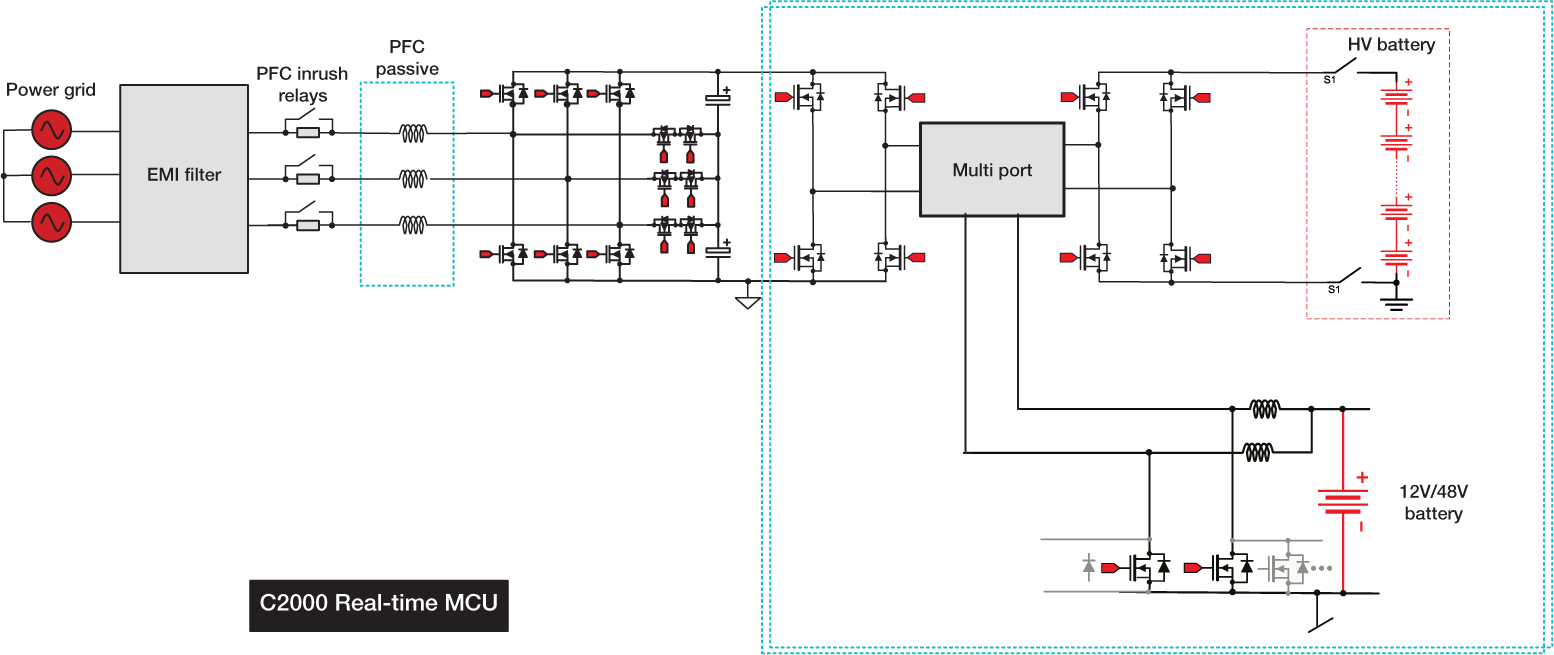SWAY033A december 2020 – december 2020 F29H850TU , F29H859TU-Q1 , LMG3410R050 , TMS320F280025 , TMS320F280025-Q1 , TMS320F280049 , TMS320F280049-Q1 , TMS320F28377D , TMS320F28377D-Q1 , TMS320F28377S , TMS320F28377S-Q1 , TMS320F28384D-Q1 , TMS320F28384S-Q1 , TMS320F28386D-Q1 , TMS320F28386S-Q1 , TMS320F28388D , TMS320F28P650DH , TMS320F28P650DK , TMS320F28P650SH , TMS320F28P650SK , TMS320F28P659DH-Q1 , TMS320F28P659DK-Q1 , TMS320F28P659SH-Q1
Scalable portfolio of real-time MCUs for onboard chargers
OBCs range from 3.3 kW for plug-in hybrid EVs to 6.6 to 22 kW for EVs. Popular architectures for 3.3- to 6.6-kW OBCs include totem-pole PFC and CLLLC. Table 1 lists the different real-time MCU choices available based on the system architecture, as well as integration options.
| Minimun resource requirements | Typical real-time MCU option | |||||
|---|---|---|---|---|---|---|
| PWMs | ADCs | MIPS | Separate controller | Single controller for OBC, separate for HV/LV DC/DC | Single integrated controller | |
| 3.3kW/6.6kW OBC PFC stage (totem-pole PFC) | 2 | 5 | 70 | F280025 | F280049 | F2837S |
| 3.3kW/6.6kW OBC DC/DC converter (CLLLC) | 8 | 5 | 50 | F280025 | F280025 | |
| 3kW High-voltage to low-voltage DC/DC converter | 6 | 5 | 40 | F20025 | ||
For 11kW and higher OBCs, one approach is to stack three 3.6-kW chargers (which are topology-wise similar to 3.3-kW chargers); this is referred to as the modular OBC approach. It’s also possible to design additional 22-kW chargers by stacking 11-kW chargers or increasing the power rating by paralleling or by selecting different field-effect transistors (FETs). Another approach to 11kW uses a three-phase PFC front end with some derating for single-phase operation.
The approach selected by the OEM can vary based on geographic region. For example, in the U.S., single phase is more readily available, so a modular approach is popular. In Europe or Asia, where three phase is more readily available, a three-phase PFC can offer higher density and lower costs, since the system requires fewer power devices and switches. To address this wide range of power levels, look for a scalable controller portfolio that can not only handle advanced topology control but also enable integration. The C2000 MCU portfolio (Table 3), ranging from low to mid to high end devices, enables the system implementation options in Table 1 and Table 2.
| Minimun resource requirements | Typical real-time MCU option | ||||
|---|---|---|---|---|---|
| PWMs | ADCs | MIPS | Separate controller | Single integrated controller | |
| 11kW modular OBC (PFC plus DC/DC converter) | 10 | 10 | 120 | Three F280049s | F28388D |
| 3kW high-voltage to low-voltage DC/DC converter | 6 | 5 | 40 | F280025 | F28388D |
| 11kW OBC PFC stage (T-Type) | 12 | 8 | 50 | F280025 | |
| 11kW OBC DC/DC stage (two DC-DC converters, 5.5kW each) | 16 | 8 | 100 | F280049 | |
| Device | PWM | ADC | MIPS |
|---|---|---|---|
| F280025 | 14 | 16 | 100 |
| F280049 | 14 | 21 | 200 |
| F28377D | 24 | 24 | 800 |
| F28388D | 32 | 24 | 925 |
In the modular approach (which stacks three single-phase chargers to reach 11 kW), each module is designed for 3.6 kW, works with a single-phase AC input, and typically has a single-phase PFC stage and a DC/DC stage (Figure 5). The high-voltage and low-voltage DC/DC converter connects to the high-voltage battery on one end and the 12-V battery on the other. The existence of multiple isolation planes in the system allows for the design of a single controller for each phase, with a separate controller (using the F280049) or a single controller (such as the F28388) controlling all three stages of the OBC. The F280025 can also control the high-voltage to low-voltage DC/DC converter, as it provides the necessary advanced analog integration to control the phase-shifted full-bridge power stage.
 Figure 5 11-kW OBC with 3.6-kW Stacked Chargers and a High-voltage to Low-voltage DC/DC Converter.
Figure 5 11-kW OBC with 3.6-kW Stacked Chargers and a High-voltage to Low-voltage DC/DC Converter.If the power stage is not modular, you can control the entire system using a single controller. Figure 6 shows one such example, using a T-type three-phase PFC and an interleaved dual active bridge (DAB) converter for the OBC. (Table 2 listed several MCU choices for this system.) The F28388D device from the C2000 real-time MCU family can control all of the power electronics in the system. As OEMs optimize these systems, concepts such as “one-box” are gaining momentum, where the OBC and high-voltage to low-voltage DC/DC converter are housed in the same enclosure. The one-box concept opens up additional options by using multiport converters that share the DC/ DC stage between the OBC DC/DC stage and high-voltage to low-voltage DC/DC converter.
 Figure 6 11-kW OBC plus a High-voltage to Low-voltage DC/DC Converter Controlled Using the F28388D.
Figure 6 11-kW OBC plus a High-voltage to Low-voltage DC/DC Converter Controlled Using the F28388D. Figure 7 An 11-kW OBC plus High-voltage to Low-voltage DC/DC Converter Using a Multiport Scheme Controlled by the F28388D.
Figure 7 An 11-kW OBC plus High-voltage to Low-voltage DC/DC Converter Using a Multiport Scheme Controlled by the F28388D.Now that a single controller is controlling all of the stages, further optimizations become possible. Figure 7 shows the use of a multiport converter, which reduces the number of switches/high-voltage FETs required by 16%.